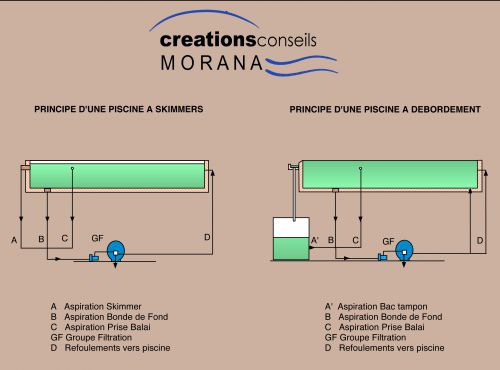Understanding the Overflow Concept
For a lot of people, overflow swimming pools seem to be very mysterious and unnecessarily expensive. Indeed, throughout my career I have seen people being opposed to the construction of overflow swimming pools for a number of reasons, some of the most notable ones reprimanding their excessive water consumption or prohibitive costs.
I think it is time to take a step back in order to separate truisms from popular fallacies. With the help of the diagrams below, we’re going to look at the overflow concept without getting bogged down by overly technical details.
Water Consumption
In simple terms, there is absolutely no difference between a skimmer pool and an overflow pool in regards to the loss of water.
In a skimmer pool, the water from the pool is sucked into the filtration system by the skimmer so that it may be filtered and then returned to the pool: In other words, it is closed circuit. Here, the only loss of water happens naturally through evaporation, which is most common during the summer.
With an overflow pool, instead of having the water sucked in by the skimmer, it is collected in a “water tank”. The water is then filtered and redistributed to the pool through a mixture of different return inlets ( floor & multi-flow). Since the pool is already full, the incoming water automatically spills over into the water tank, creating the overflow effect. Although the circuit is “technically” not closed, it is always the same water that flows in and out of the filtration system.
So, no need to worry about issues of water consumption.
Cost?
One last point which might be of interest to you: Many wonder about the costs of such pools. As illustrated by the diagram, they require a few additional elements: 1) A gutter to re-direct the water to the 2) water tank, 3) a check valve, 4) a buffet tank control to avoid the loss of water and 5) a system of water adjustment by solenoid valves ( to protect the pump). That’s all!
Whilst it certainly may be an additional cost, it isn’t as significant as some might expect.
When preparing a swimming pool project, it is highly advisable to ask for an estimate of an overflow swimming pool: not only is it highly beneficial in terms of the quality of the water, but it is also an undeniable aesthetic bonus!
You would like to discuss about your project, contact us!
Visit our website
A découvrir aussi
Inscrivez-vous au blog
Soyez prévenu par email des prochaines mises à jour
Rejoignez les 71 autres membres

